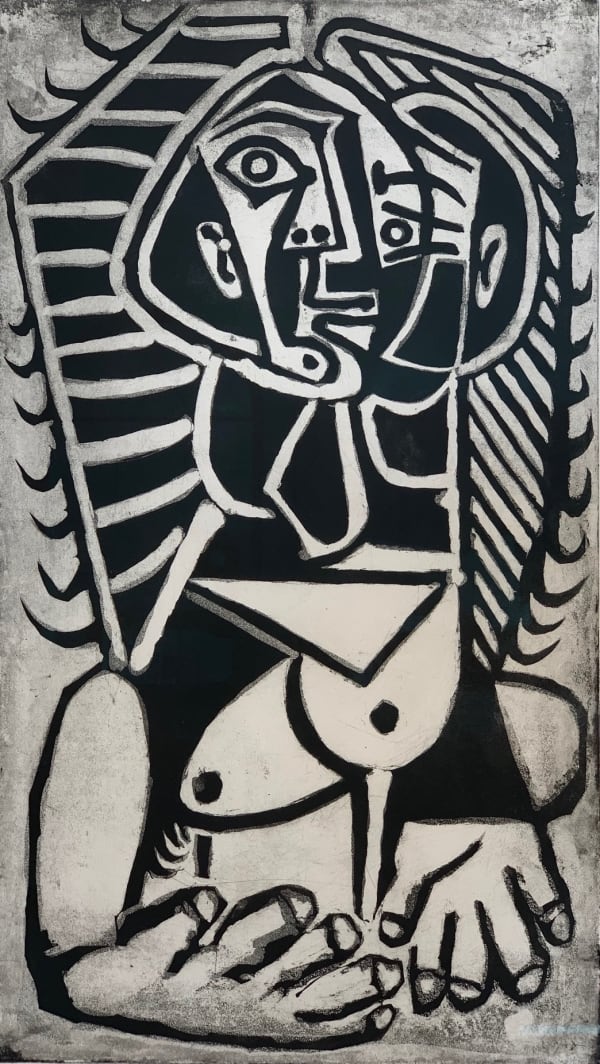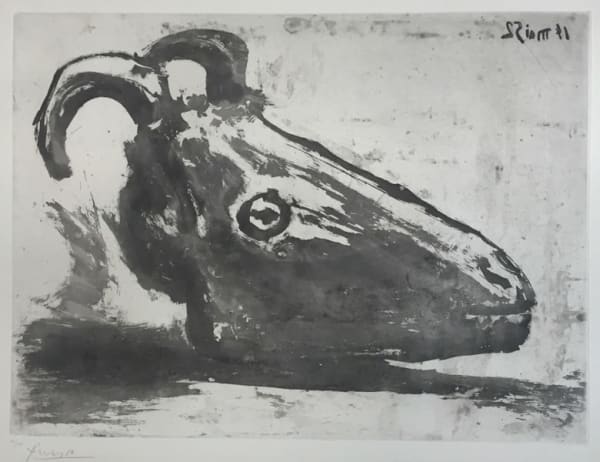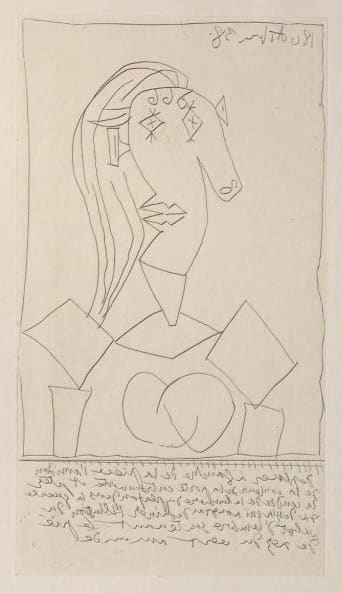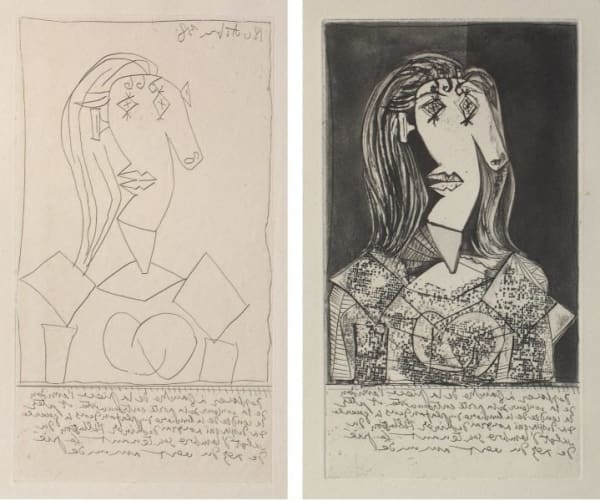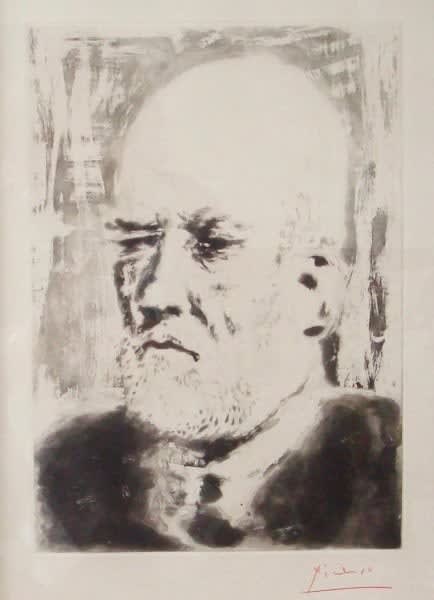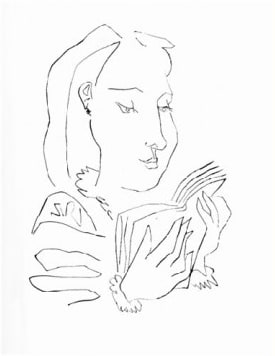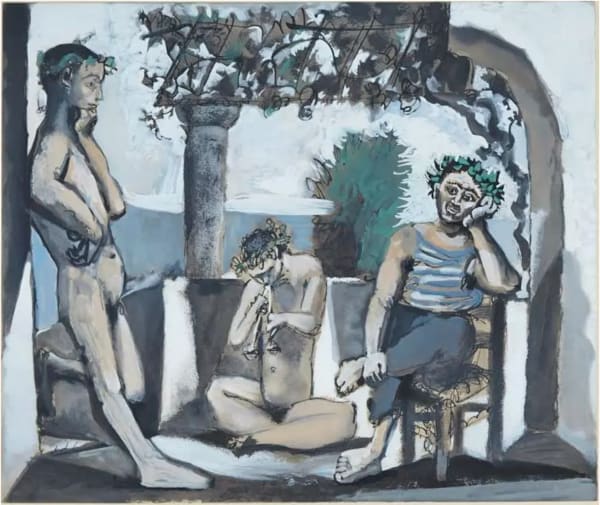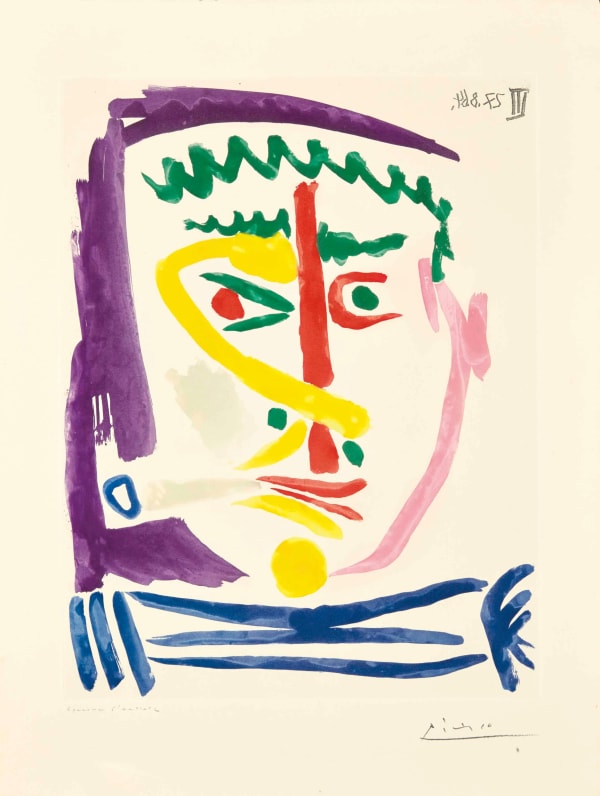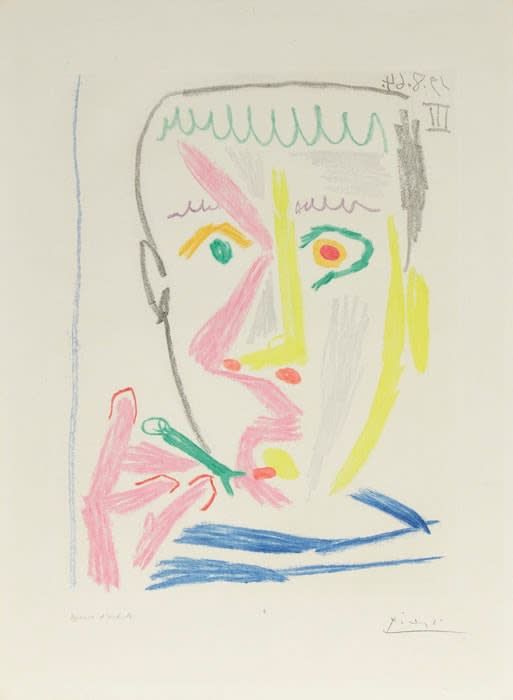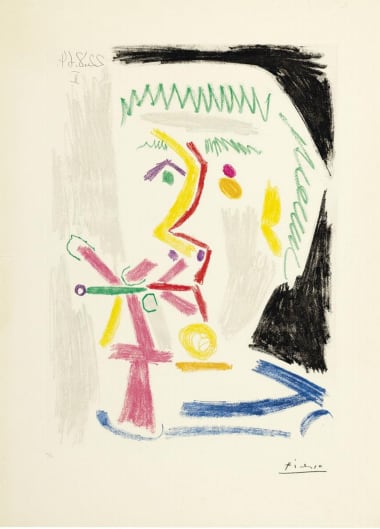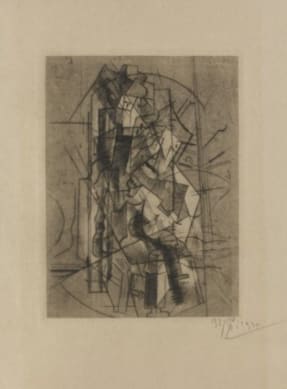
Pablo Picasso
Signed
28.2 x 19.3 cm
L’Homme à la Guitare, 1915–1929, an aquatint and etching on Japon paper. It is a striking example of Picasso’s engagement with Cubism in printmaking, where he translated the radical fragmentation of form and space into the delicate yet powerful medium of etching.
The composition depicts a seated man holding a guitar, though the figure and instrument are broken into angular planes, overlapping lines, and geometric abstractions characteristic of Cubist language. The body and guitar are fused into a complex network of intersecting forms, making it difficult to separate figure from object—a hallmark of Synthetic and Analytic Cubism.
Despite the abstraction, the centrality of the guitar is clear: its curving body and neck appear amidst the vertical and diagonal lines, anchoring the image in the motif of music. The background, similarly fractured, enhances the sense of a multi-perspective viewpoint, where form is seen simultaneously from different angles.
The tonal richness of the aquatint technique adds depth, balancing the sharpness of etched lines with velvety shadow, giving volume to what might otherwise be flat planes.
This work combines aquatint and etching, a pairing that allowed Picasso to integrate precise linear definition with subtle tonal gradations. The aquatint produces areas of rich shadow, lending a sense of depth and atmosphere, while the etched lines construct the scaffolding of the Cubist composition.
Printed on delicate Japon paper, the work gains an added refinement: the paper’s smooth surface and slight translucency enhance the delicate tonal effects and the contrast between ink and paper. This choice of material reflects Picasso’s sensitivity to the expressive qualities of print surfaces.
L’Homme à la Guitare highlights Picasso’s fascination with the guitar, an instrument that became one of the most enduring motifs of his Cubist period. The guitar symbolized not only music but also the interplay between structure and harmony, resonating with the principles of Cubism itself.
The work is also emblematic of Picasso’s efforts to extend Cubism beyond painting, bringing its innovations into printmaking, sculpture, and collage. By the 1910s–1920s, Cubism was no longer a radical experiment but a language he had mastered and adapted across media.
The fragmentation of the figure can also be read as a reflection of modernity itself: the shattering of traditional perspective and representation in favor of a dynamic, multifaceted vision of reality.
L’Homme à la Guitare (1915–1929) is an aquatint and etching on Japon paper by Pablo Picasso. The work depicts a seated man with a guitar, rendered in fractured planes and geometric forms characteristic of Cubism. Executed with a combination of etched lines and tonal aquatint, the print exemplifies Picasso’s translation of Cubist principles into printmaking, uniting structure, rhythm, and abstraction. Printed on Japon paper, the work embodies both technical refinement and avant-garde innovation, reaffirming the guitar as one of Picasso’s most iconic motifs.
For more information or to buy L’Homme à la Guitare by Pablo Picasso, contact our galleries using the form below.-
 Pablo PicassoTête Homme au Maillot Rayé, 1964
Pablo PicassoTête Homme au Maillot Rayé, 1964 -
 Pablo PicassoEcce Homo, d’Après Rembrandt, 1970
Pablo PicassoEcce Homo, d’Après Rembrandt, 1970 -
 Pablo PicassoCaricature of General de Gaulle and Two Women, from: Series 347| Caricature du général de Gaulle et deux femmes, 1968
Pablo PicassoCaricature of General de Gaulle and Two Women, from: Series 347| Caricature du général de Gaulle et deux femmes, 1968 -
 Pablo PicassoNature Morte au Citron et au Pichet Rouge, 1955
Pablo PicassoNature Morte au Citron et au Pichet Rouge, 1955 -
 Pablo PicassoTorse de Femme, 1953
Pablo PicassoTorse de Femme, 1953 -
 Pablo PicassoLe Crane de Chevre, 1952
Pablo PicassoLe Crane de Chevre, 1952 -
 Pablo PicassoBuste de Femme (Dora Maar) State I (Bloch 308), 1938
Pablo PicassoBuste de Femme (Dora Maar) State I (Bloch 308), 1938 -
 Pablo PicassoDora Maar, 1938
Pablo PicassoDora Maar, 1938 -
 Pablo PicassoPortrait of Vollard II, 1937
Pablo PicassoPortrait of Vollard II, 1937 -
 Pablo PicassoFemme Lisant, 1948
Pablo PicassoFemme Lisant, 1948 -
 Pablo PicassoBacchanale, 1960
Pablo PicassoBacchanale, 1960 -
 Pablo PicassoFumer III, 1964
Pablo PicassoFumer III, 1964 -
 Pablo PicassoFumer , 1964
Pablo PicassoFumer , 1964 -
 Pablo PicassoFumeur A La Cigarette Verte, 1964
Pablo PicassoFumeur A La Cigarette Verte, 1964 -
 Pablo PicassoTête de Femme III: Portrait of Dora Maar, 1939
Pablo PicassoTête de Femme III: Portrait of Dora Maar, 1939
Join our mailing list
* denotes required fields
We will process the personal data you have supplied in accordance with our privacy policy (available on request). You can unsubscribe or change your preferences at any time by clicking the link in our emails.
This website uses cookies
This site uses cookies to help make it more useful to you. Find out more about cookies.




